This post may contain affiliate links. Please read my privacy policy.
Learn how to make authentic Shui Jiao (Sui Kow), flavorful Chinese dumplings stuffed with a savory mix of shrimp, pork, and vegetables. Perfect in soup, this step-by-step recipe, with a cooking video, will help you make restaurant-quality dumplings at home.

Homemade Sui Kow
Sui Kow—or Shui Jiao (水饺) in Chinese—is a traditional Chinese dumpling filled primarily with ground pork, coarsely diced or whole shrimp, and other chopped vegetables like water chestnuts. While Sui Kow is often paired with Chinese wonton noodles, it can also be served separately in a flavorful boiled broth, making it a versatile and comforting dish.
These little morsels of goodness have been my childhood favorite, and I’ve never gotten bored of Shui Jiao dumplings, even to this day. I must say that it is the best sui kow I had tried so far. The taste and texture are simply AWESOME!
This is an authentic Shui Jiao (sui kow) recipe, inspired by the great Cantonese cooks in Malaysia. By sharing this recipe, I hope you’ll love them just as much as I do.
Check out my Steamed Dumplings recipe next for more easy and delicious dumplings!
Sidenote: Sui Kow is the Cantonese pronunciation and is sometimes also spelled as Sui Gow or Sui Gao.
How to Serve Shui Jiao

These dumplings are commonly served in a light bone broth, topped with chopped scallions and a dash of sesame oil. For a healthy and well-rounded meal, I recommend pairing Sui Kow with blanched Chinese greens like Choy Sum or Bok Choy. Add some Chinese egg noodles, and you’ve got a complete, substantial dish—perfect for brunch or lunch.
To enjoy the dumplings, you can eat them as they are, or add some Pickled Green Chilies for an extra kick. If you’re a fan of cilantro (coriander leaves), place a single leaf on top of the Sui Kow. For an added burst of flavor, dip the dumplings into a spicy condiment like chili sauce, chili crisps, or soy sauce-chili oil… just the thought of it has my stomach rumbling!
Recipe Variations: For an added layer of flavor, make a vinegary, spicy, and mala soy sauce mixture (like the one in my Red Oil Wontons recipe) and combine boiled Shui Jiao with the sauce. Trust me, it’s heavenly! The tangy, spicy, and numbing sauce perfectly complements the delicate dumplings for an unforgettable taste experience!
What You’ll Need

The ingredients for Shui Jiao are as follows:
- Ground pork
- Shrimp – coarsely chopped in my recipe but you may use whole, depending on your preference.
- Water chestnuts – Called ma tai (马蹄) in Cantonese, they have a smooth, dark brown exterior and a crisp, white, and mildly sweet interior, offering a refreshing crunch to the Sui Gao.
- Black fungus or wood ear mushrooms – soaked and sliced into strips for added texture.
- Coriander leaves/cilantro – fresh and chopped
- Seasonings: oyster sauce, salt, sugar, sesame oil, cornstarch, and ground white pepper.
- Dumpling wrappers – store-bought or homemade
- Chicken broth
Sidenote: Water chestnuts are the secret ingredient in this recipe. They add a delightful crunch and subtle sweetness that perfectly balance the savory filling of pork and shrimp. The texture they bring to the dumpling is unique and refreshing, making each bite extra special. In the United States, you can find water chestnuts fresh in Asian supermarkets or canned in the canned food aisle.
How To Make Shui Jiao
I’ll guide you through the easy step-by-step below:

Step 1: Rinse the shrimps and pat them dry with paper towels. Place the shrimps on a cutting board. Using the flat side of a cleaver, gently smash and flatten the shrimps, then chop and mince into a slightly chunky consistency.

Step 2: In a mixing bowl, combine the shrimps, ground pork, water chestnuts, black fungus, coriander leaves, and seasonings. Stir the mixture until well combined. Cover the bowl with cling wrap and chill the filling in the fridge for 30 minutes.

Step 3: To wrap the Shui Jiao dumpling, place a dumpling wrapper in the palm of your hand and spoon about 1 tablespoon of the filling into the center. DO NOT OVERFILL.

Step 4: Wet the outer edge of the dumpling wrapper with a little water, fold it in half, and press firmly to seal the edges. Place the wrapped dumpling on a tray lightly dusted with flour to prevent sticking.

Step 5: Fill a soup pot about two-thirds full with water, add 1 tablespoon of oil, and bring it to a boil. Working in batches, gently add the dumplings one at a time, stirring clockwise with a spatula to prevent them from sticking to each other or the pot. Repeat the process until all the dumplings are cooked.

Step 6: To serve, place a few dumplings in a bowl, ladle hot chicken broth over them, add a dash of sesame oil, garnish with chopped scallions and serve immediately. For an extra touch, you can add blanched Chinese leafy green vegetables to the broth.
Helpful Tips For Dumpling Beginners

After making Chinese dumplings for over 20 years, I’d like to offer the following pro tips, especially if you’re a beginner:
- Seal the Dumplings Well: I always make sure the edges are tightly sealed to prevent the filling from leaking out while cooking.
- Don’t Overstuff: I use just a small amount of filling (scant 1 tablespoon or 1 teaspoon), as overstuffing makes it harder to seal the dumplings and can cause them to burst.
- Use Warm Water for Wrappers: I find that moistening the edges with warm water helps create a stronger seal when folding.
- Cook in Batches: When boiling the Shui Jiao dumplings, I cook them in small batches to prevent them from sticking together.
Frequently Asked Questions
Absolutely! You can use mushrooms, finely diced bok choy, carrots, or napa cabbage, tofu, and glass noodles. Add water chestnuts and bind the filling with some cornstarch.
If your dumplings are sticking, it’s usually because there isn’t enough water in the pot. Add one tablespoon of oil into the boiling water also helps. Stir the dumplings gently in one direction after adding to the boiling water to prevent sticking. Also, cook in small batches.
Overfilling and improper sealing are the main reasons whey dumplings burst or leak during the boiling process. Leave enough space around the edges of the wrapper and press firmly to seal. Use a little water to seal tight.
Yes! Line a tray with parchment paper and arrange them in a single layer, freeze until solid. Then transfer to a sealed bag or container. Boil directly from frozen for best results, adding an extra minute or two to the cooking time.
This recipe is only 179 calories per serving.

Dumpling Recipes You Might Like
If you love Chinese dumplings, you will love the following homemade recipes. Check them out:
I hope you enjoy this post as much as I do. If you try my recipe, please leave a comment and consider giving it a 5-star rating. For more easy and delicious recipes, explore my Recipe Index, and stay updated by subscribing to my newsletter and following me on Facebook, Pinterest, and Instagram for new updates.
Other Recipes You Might Like

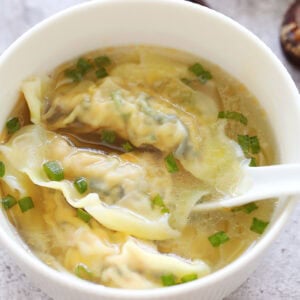
Shui Jiao (Sui Kow) Recipe
Ingredients
- 160 g (5¾ oz) peeled and deveined shrimp
- 80 g (3 oz) ground pork
- 3 pieces water chestnuts, peeled and diced into small pieces
- 2 pieces black fungus, soften in warm water and cut into thin strips
- 1 tablespoon coriander leaves, finely chopped
- 25 pieces dumpling wrappers
- water , for boiling
- 1 tablespoon oil
- 2 cups chicken broth, add 1 cup of water to dilute
- sesame oil, optioal
- 1 stalk scallions, cut into rounds
- Chinese leafy green vegetables, optional
Seasonings:
- 2 tablespoons oyster sauce
- 1 teaspoon salt
- 1 teaspoon sugar
- 1 teaspoon sesame oil
- 2 teaspoons cornstarch
- 3 dashes ground white pepper
Instructions
- Rinse the shrimps and pat them dry with paper towels. Place the shrimps on a cutting board. Using the flat side of a cleaver, gently smash and flatten the shrimps, then chop and mince into a slightly chunky consistency.
- In a mixing bowl, combine the shrimps, ground pork, water chestnuts, black fungus, coriander leaves, and seasonings. Stir the mixture until well combined. Cover the bowl with cling wrap and chill the filling in the fridge for 30 minutes.
- To wrap the Shui Jiao dumpling, place a dumpling wrapper in the palm of your hand and spoon about 1 tablespoon of the filling into the center. DO NOT OVERFILL.
- Wet the outer edge of the dumpling wrapper with a little water, fold it in half, and press firmly to seal the edges. Place the wrapped dumpling on a tray lightly dusted with flour to prevent sticking.
- Fill a soup pot about two-thirds full with water, add 1 tablespoon of oil, and bring it to a boil. Working in batches, gently add the dumplings one at a time, stirring clockwise with a spatula to prevent them from sticking to each other or the pot. Repeat the process until all the dumplings are cooked.
- To serve, place a few dumplings in a bowl, ladle hot chicken broth over them, add a dash of sesame oil, garnish with chopped scallions and serve immediately. For an extra touch, you can add blanched Chinese leafy green vegetables to the broth.
Video
Notes
Nutrition
Nutrition information is automatically calculated, so should only be used as an approximation.
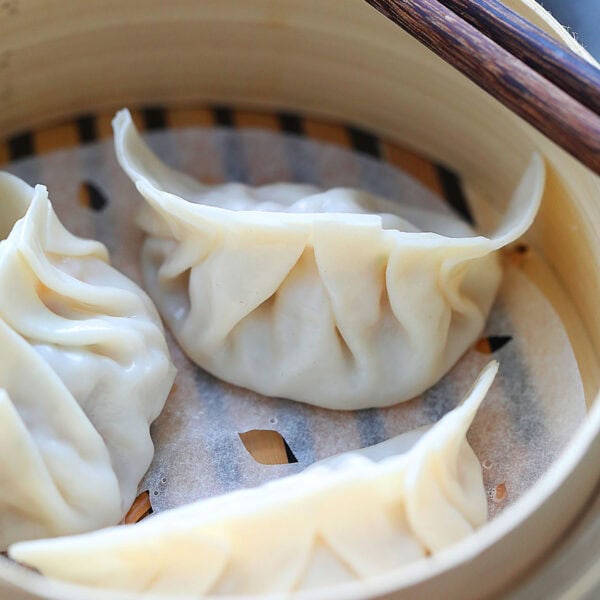
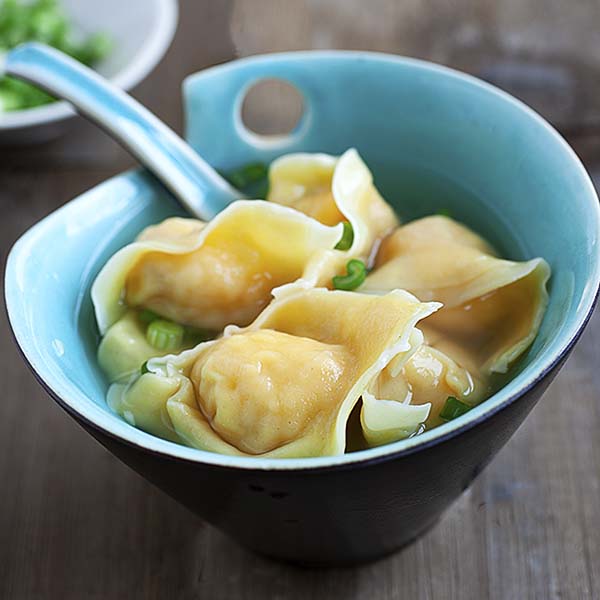
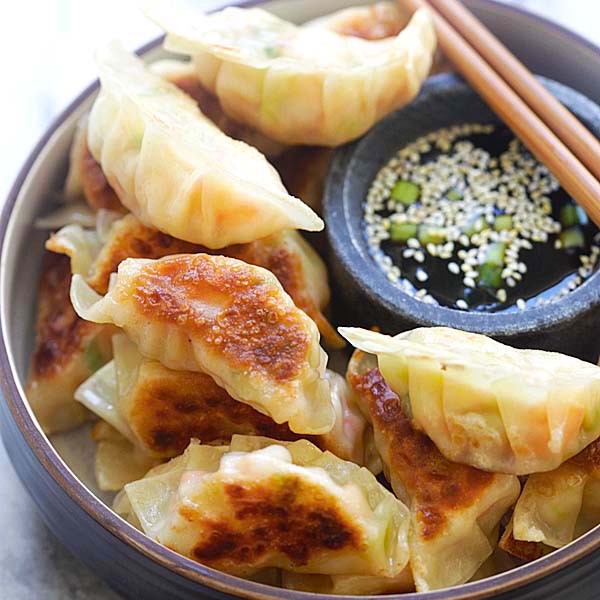
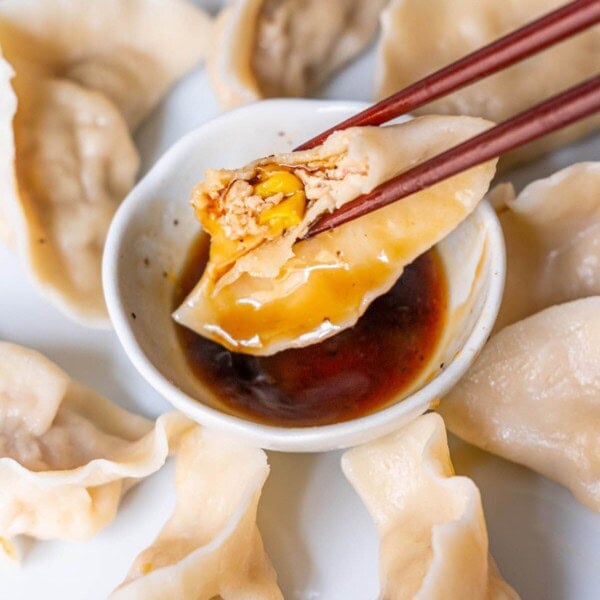






This style of dumpling has been disappearing from restaurants. 30 years ago they were quite prevalent in NYC Chinatown in soup as well as pan fried. Now it seems that most places only have the smaller all pork pan fried dumplings I really miss this sui kow style.
Did you make your own wrappers or used the packaged ones? Ours did not turn out nice and wrinkly like yours in the photo.
Just made it today, it is was the best Sui Kow I have tasted. Everyone at home loved it . Thank you
Hi Garfield, thanks for trying my siu kow recipe. :)
Chanced upon your recipes on shui jiao…just wondering if It’s possible to refridgerate the uncooked shui jiao?